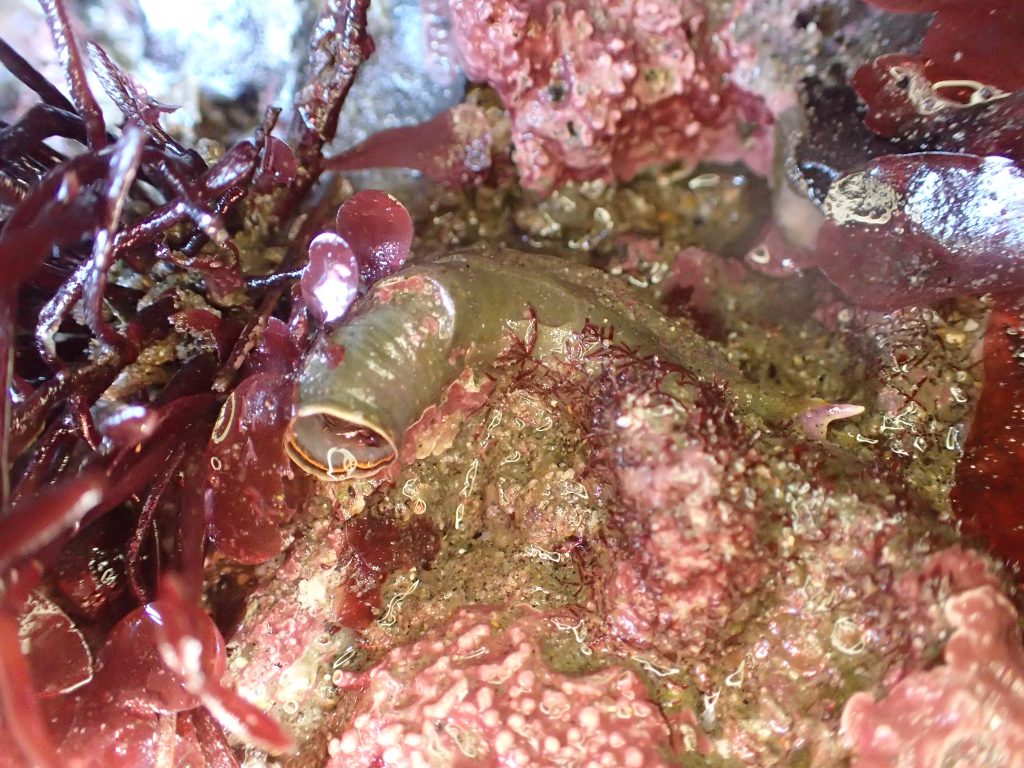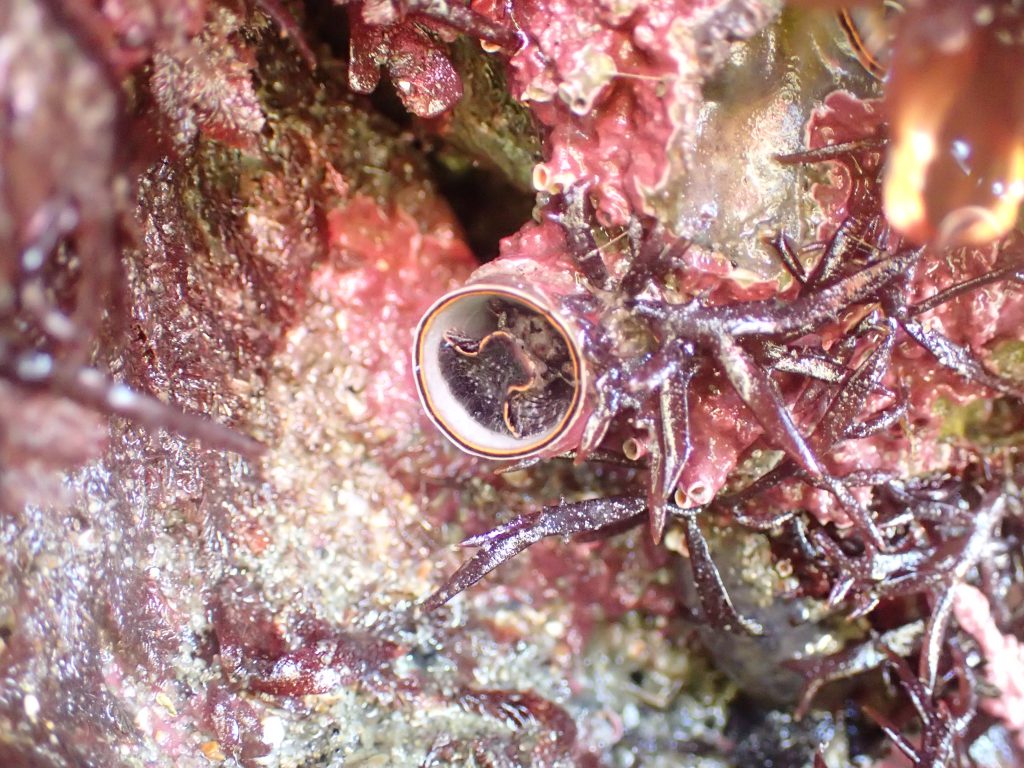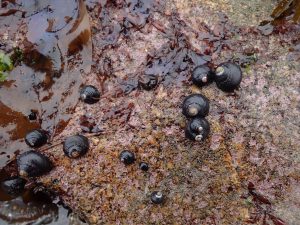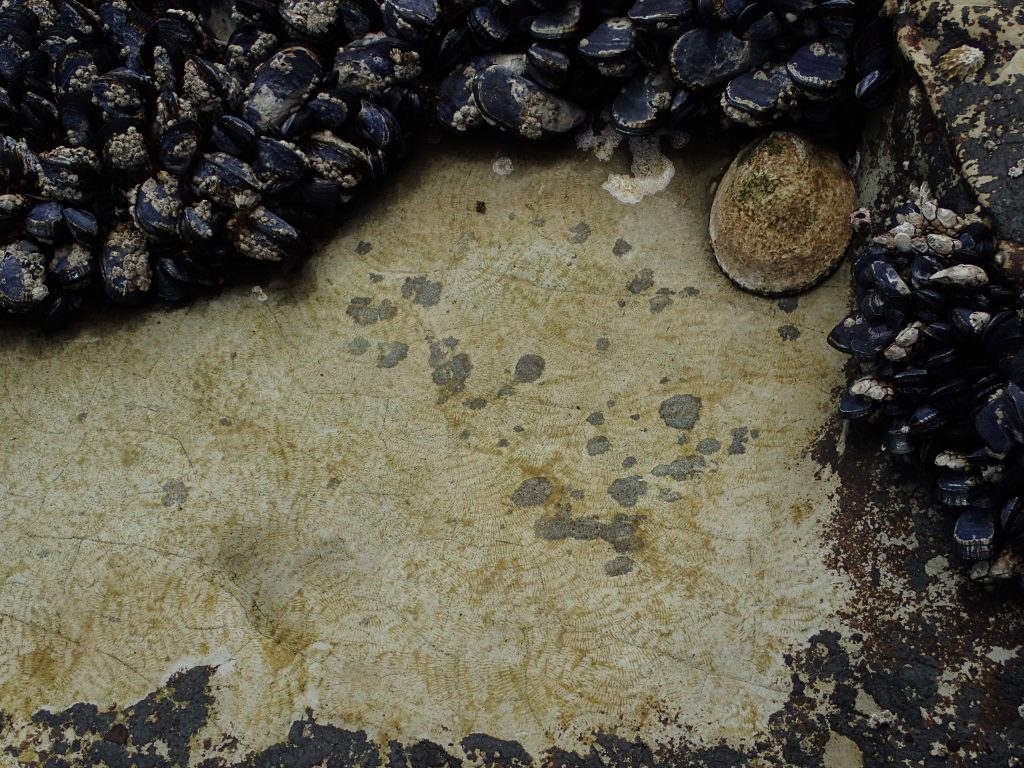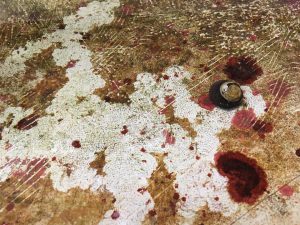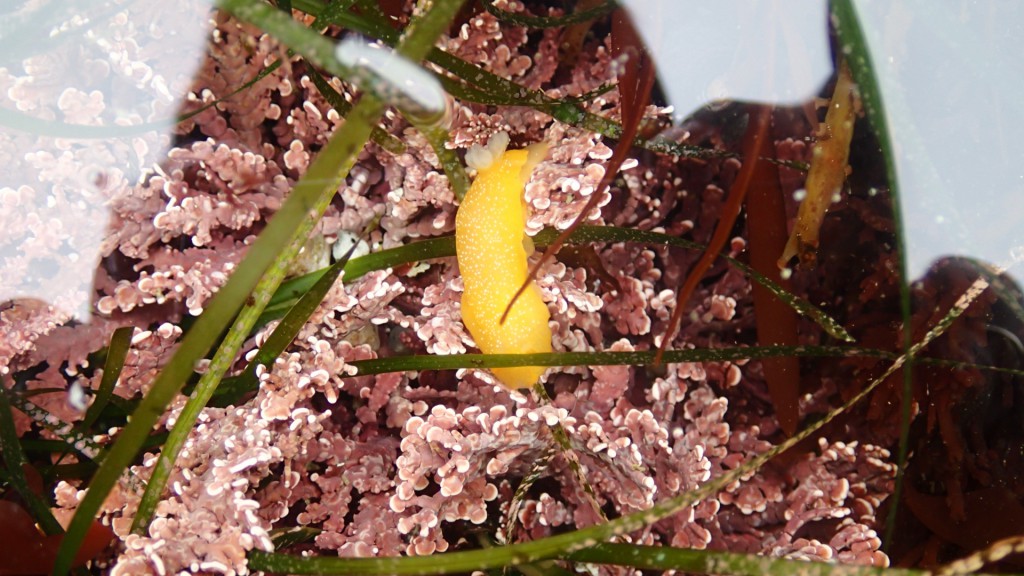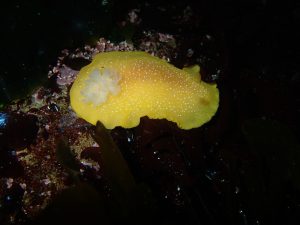This past Monday I did something rare for me: I returned to the same intertidal site I had visited the previous day. I enjoyed myself so much the first time that I wasn’t able to refuse an invitation to go out there again. The site, Pigeon Point, is one of my favorites, especially in all of its spring glory as it is now. It has always been a hotspot especially for macroalgal diversity, and so far this year appears to be living up to its reputation. The day before I collected several reds that I got to spend the next two days trying to identify.

1 May 2017
© Allison J. Gong
On Monday I was less overwhelmed by obsessed with algae and able to focus more on the animals, and was delighted to find a small cluster of Thylacodes squamigerus, the strange and fascinating vermetid snail. Nearby one of the vermetid snails was a yellow nudibranch (Doriopsilla albopunctata) and one of the common turban snails (Tegula funebralis). The chance proximity of three different gastropods brought to mind the incredible diversity of this group of molluscs.
The Gastropoda are the largest group within the phylum Mollusca, and can claim a fossil record that dates back to the early Cambrian, some 540 million years ago. They have been extremely successful throughout that long time and are the only molluscan group to have established lineages in both freshwater and on land (of the other molluscs, only the bivalves have made it into freshwater, with the remaining groups restricted to the sea). As you might expect, this evolutionary history has given rise to a mind-boggling array of body types and lifestyles. Let’s investigate this diversity by taking a closer look at the three gastropods in the photo above.
Gastropod #1 (Thylacodes squamigerus): Very few people, on seeing this animal for the first time, would guess that it’s a snail. Most would say that it’s a serpulid worm. The tube is calcareous, as it is for serpulid worms, and winds around over rocks in the intertidal.
A close look at the opening of the tube, however, reveals snail-like rather than worm-like features. Thylacodes even has a snail’s face, although I’ll admit it isn’t easy to see if you don’t know to look for it. And despite crawling under a ledge with my camera, I didn’t get the best view of a face. In this photo, however, you can at least see one of the cephalic tentacles:
Living in a tube cemented onto a rock means that Thylacodes can’t go out and find food. It must instead catch food and bring it in. Thylacodes does so by spinning threads of sticky mucus that are splayed out into the water, where they capture plankton and suspended detritus. The threads are then reeled in and everything–mucus and food–is eaten by the snail. Thylacodes tends to occur in groups, and individuals within an aggregation contribute threads to a communal feeding net, which presumably can catch more food than the sum total of all the snails’ individual efforts.
Pretty unexpected for a snail, isn’t it?
Gastropod #2 (Tegula funebralis): The black turban snail is probably one of the most common and commonly overlooked animals in the intertidal. People don’t see them because these snails are, literally, everywhere from the high- down into the mid-intertidal. They are routinely stepped over as visitors rush to the lower intertidal, and ignored again as these same visitors leave the seashore. I love them. I keep them in the lab as portable lawnmowers for the seawater tables. They are incredibly efficient grazers, keeping the algal growth down. Plus, I think they’re cute!
If there’s such thing as a ‘typical’ marine snail, T. funebralis may very well be it. This little snail exemplifies several of the traits we use to define the Gastropoda: it lives in a coiled shell, it uses a radula for scraping algal film off rocks (yum!) and is torted. The shell is easy enough to understand, as everyone has seen a snail at some point, even if it was a terrestrial snail. The radula and torsion, however, may take a little explaining.
Many molluscs have a radula, a file-like ribbon of teeth that can be stuck out of the mouth and used for feeding. In gastropods the radula can be a scraping organ (as in Tegula and other herbivores such as limpets), a drill (as in the predatory moon snails, which drill holes into unsuspecting clams and then slurp out their soft gooey bodies), or a poison dart (as in the venomous cone snails). The radula of a grazer such as Tegula bears many transverse rows of sharp teeth, which are regularly replaced in a conveyor belt fashion as they are worn down. This assures that the teeth being used are always nice and sharp. Remember the radula marks made by the owl limpet (Lottia gigantea)?
Those zig-zaggy marks are made by the scraping of the radula as the limpet crawls over her farm. Tegula funebralis makes the same type of pattern in my seawater tables. All of that white territory is area that had been scraped clean of algae in about a day. Tegula is a very industrious little snail! And they’re not shy, either. I don’t have to wait a day or so for them to get acclimated when I bring the back to the lab. I can move them around from table to table and after a few seconds they poke their heads out and start cruising around. I’ve learned from watching them over the years that they seem to have an entrained response to the rising and falling of the tides, even after I bring them into the lab. For the first few weeks of captivity, every morning when I first get to the lab I find that several Tegula have climbed up the walls. I think they’re crawling up when the tide is high. I really should look at that more carefully. They never go too far, but sometimes they do drop onto the floor and I find them by stepping on them. Fortunately they are hardy creatures and the floor is always wet with seawater so as long as I find them within a day and plunk them back into the table they’re fine.
Now on to torsion. Torsion is difficult to explain, but let me try. The word ‘torsion’ refers to the twisting of the nerve cord and some internal organs that occurs during larval development of gastropods. Here’s how it works. Imagine a closed loop, like a long piece of string with the ends tied together. Lay the loop down on a table and it is just a simple loop. Pick up one end of the loop, twist it counterclockwise 180°, and lay it down again. Now you have a figure-8, right? That’s not exactly what happens in the living snail, but you get the picture.
Tegula and other snails have an elongated body that is coiled and crammed to fit inside the shell. If you could take Tegula’s body and stretch it out without breaking it (impossible to do, BTW), you’d see the figure-8 configuration of the nerve cord. Other internal organs are re-arranged by torsion, too. As a result, both the gill(s) and the anus now open into the mantle cavity which has been relocated over the head. This arrangement is ideal for keeping the gill(s) irrigated, but not so good for hygienic reasons. Fortunately, the mantle cavity itself is angled so that water flows through it in a more-or-less unidirectional manner, passing over the gill before the anus. Tegula and other marine snails undergo torsion while in the larval stage, and remain torted as adults. This is not the case in other gastropods, as we’ll see next.
Gastropod #3 (Doriopsilla albopunctata): Everybody loves the nudibranchs, because their brilliant colors make them easy to love. Unlike the oft-undetected Thylacodes squamigerus and the ignored Tegula funebralis, many of the nudibranchs are somewhat easy to spot in the field because of their flamboyance. This is a crappy picture, but you get the point.
Doriopsilla albopunctata is one of several species of yellow dorid nudibranchs lumped together under the common name ‘sea lemon’. Instead of the long fingerlike processes (cerata) that adorn the backs of the aeolid nudibranchs such as Hermissenda spp., the dorids have smooth or papillated backs that may be decorated with rings or spots. Dorids also have a set of branchial plumes on the posterior end of the dorsum; the number and color of these gills can often be used to distinguish similar species. Doriopsilla albopunctata has a smooth yellow back with little white spots, hence the species epithet (L: ‘albopunctata’ = ‘white pointed’), and white branchial plumes.
Nudibranchs are gastropods, although in a different group from Thylacodes and Tegula. The marine slugs, of which the nudibranchs are the most commonly encountered, are in a group called the Opisthobranchia, whose name means ‘gill on back’ and refers equally to the cerata of aeolids and the branchial plume of dorids. In fact, these animals lack the typical molluscan gill that the snails have. They do have a radula, however, and crawl around on a single foot exactly like Tegula does.
An adult nudibranch’s body is elongated, unlike the coiled body of Tegula, and has no apparent signs of having undergone torsion. However, examination of larval nudibranchs shows that they do undergo torsion just like any other respectable gastropod. The weird thing is that some time during the transition from pelagic larva to benthic juvenile they de-tort, or untwist their innards so that their internal anatomy matches their external shape. Instead of having to poop on their own heads, nudibranchs have an anus that is sensibly located at the rear (no pun intended) of the body.
Torsion is one of those biological curiosities whose evolutionary origin is shrouded in mystery. How did such anatomical contortions evolve? Why do gastropods, and only gastropods, undergo torsion? And why do some gastropods tort as larvae, only to detort as they become adults? There are scientific hypotheses about the benefits of torsion, particularly to the larval stages, but nobody knows for sure. After all, none of use were there to watch when it happened.
This is just a tiny taste of the diversity of the Gastropoda. I think it’s cool to see three such different gastropods in a small spot of the intertidal. And no doubt there were more that I didn’t see. That’s one of the joys of working in the intertidal: that I so often see things I wasn’t even trying to find.

